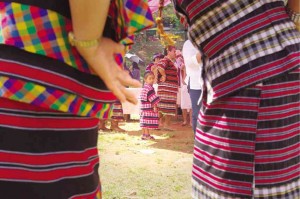
BAGUIO Ibalois celebrated Ibaloi Day only recently, after the city government acknowledged their role in the city’s history. But recently, Ibaloi ancestral land titles have been declared threats to Baguio’s environment, a charge that has offended Baguio’s original families. RICHARD BALONGLONG / INQUIRER NORTHERN LUZON
BAGUIO CITY—Did Baguio officials forget they had Ibaloi neighbors?
Speaking on behalf of Baguio’s Ibaloi community, a city councilor has accused the city government of bullying the indigenous peoples for portraying them, the beneficiaries of ancestral land titles, as “serious dangers” to the summer capital’s forest cover.
During the city council session on Aug. 5, Baguio Mayor Mauricio Domogan complained about the increase of ancestral land titles issued to Ibaloi clans that may have claimed a fifth of the city’s 57-square kilometer territory.
Domogan said many of the Certificates of Ancestral Land Title (CALT) issued to Baguio families encroach into forested parks and reservations, including a portion of land administered by the Mansion, the President’s official summer residence.
Councilor Isabelo Cosalan Jr., an Ibaloi, said in a privilege speech that the city government has been blaming Ibaloi land holders for the ill effects of rapid urbanization and an “unprecedented growth explosion” in Baguio that has begun to overwhelm local resources.
Cosalan said the National Commission on Indigenous Peoples (NCIP) issued 168 CALT as of November 2010, “covering an aggregate area of 469.9 hectares,” and the title to Baguio’s only ancestral domain covering 146.4 ha of Barangay (village) Happy Hallow within the Camp John Hay reservation. He said these are large tracts of land that would not escape Baguio’s notice.
But the city government barely blinked when it allowed national agencies to convert portions of a woodland called the Forbes Park reservation for immigrant settlements back in 1970 and again in 2000, Cosalan said.
Forbes Park, which was reserved as a 67.9-hectare forest in 1924, was one of the areas Domogan said needed protecting from CALT holders, whose titles the city government intends to nullify in court.
Yet the city government failed to object when the national government withdrew portions of the Forbes Park forest “for settlement purposes,” through Presidential Proclamation No. 773 in 1970, and Republic Act No. 8963 in 2000, Cosalan said.
“How the city government howls and growls over CALT and ancestral land claims fearing the imagined loss of a paradise but has readily turned a blind eye to the obvious,” he said.
He said the city government’s inaction through the years led to the loss of 32 ha of Forbes Park forest (or 47.7 percent of the original forest area) to informal settlers. Vincent Cabreza, Inquirer Northern Luzon